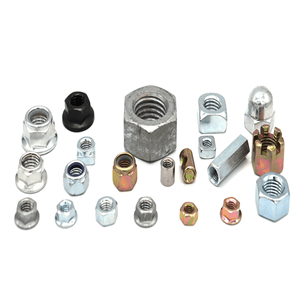Fragilisation par l'hydrogène des boulons en acier allié (1)
Hydrogen embrittlement fracture of bolts is a common form of failure. Because hydrogen embrittlement fracture is delayed and concealed, the damage it brings is much greater than the damage caused by other fractures. Since this century, hydrogen embrittlement fractures of alloy steel bolts have been commonplace, seriously hindering the normal development order of aerospace models, and have reached the level of "talking about hydrogen discoloration". In order to enable more scientific and technical personnel to understand the mechanism of hydrogen embrittlement, grasp the law of hydrogen embrittlement of bolts, and effectively prevent the occurrence of hydrogen embrittlement of bolts, the results of these studies are now written and introduced for readers' reference.
1 Mechanism and process of hydrogen embrittlement fracture
1.1 The concept of hydrogen embrittlement
Studies have shown that the possible forms of hydrogen in metals include hydrogen atoms, hydrogen ions, hydrogen molecules, methane, atomic groups, metal hydrides, etc. Among them, free hydrogen atoms, hydrogen ions, and hydrogen molecules are the main causes of hydrogen embrittlement. Hydrogen in the solid solution state is the main cause of brittle material properties. The damage points of hydrogen to metals can be roughly divided into two categories: one is that hydrogen swims and accumulates in the metal material, forming microcracks, blisters, and finally causes hydrogen embrittlement fracture; the other is hydrogen corrosion, that is, hydrogen is in the metal material. Chemical action occurs in the material to form brittle hydrides, which changes the mechanical properties of the material and causes hydrogen embrittlement fracture of the material. The hydrogen embrittlement fracture of alloy steel bolts and spring washers belongs to the former category, and the hydrogen embrittlement fracture of titanium alloy bolts belongs to the latter category.
1.2 The mechanism of hydrogen embrittlement fracture
The so-called hydrogen embrittlement fracture is the delayed fracture that occurs when hydrogen penetrates into the metal material and causes material damage, causing the material to undergo a static stress lower than the yield strength of the material. The danger is that this kind of fracture occurs below the yield limit of the material without any plastic deformation, and the delay time cannot be controlled. Therefore, hydrogen embrittlement fracture is very harmful to mechanical engineering. Only by understanding the mechanism of hydrogen embrittlement fracture and mastering the laws of hydrogen embrittlement fracture can the occurrence of hydrogen embrittlement fracture be effectively avoided.
The dissociation or diffusion of hydrogen in high-strength steel materials follows certain rules, and both the concentration gradient and the stress gradient are the driving forces for hydrogen diffusion. In other words, hydrogen will diffuse from the high-concentration area to the low-concentration area, and accumulate from the low-stress area to the high-stress area. When there are pores, inclusions, micro-cracks and other defects in high-strength steel materials or high stress concentration, the free hydrogen ions will gather to the ends of micro-cracks or high stress concentration areas under the action of stress to combine to form hydrogen molecules. At the same time the pressure of hydrogen increases. When the pressure reaches a certain level, the microcracks of the material will expand, extend, and release the pressure, while hydrogen molecules escape from the metal material in the form of hydrogen. Under the action of stress, the free hydrogen continues to accumulate towards the end of the expanded microcracks to form new hydrogen molecules, which causes the microcracks to continue to expand and evolve into larger cracks. Such repeated continuation and repeated accumulation of hydrogen continuously form hydrogen molecules, and the material cracks continue to increase and expand, eventually leading to the fracture of the metal material. This mechanism determines the delay of hydrogen embrittlement fracture and the uncertainty of delayed fracture time.
The movement of hydrogen in high-strength steel materials is a reversible phenomenon. It can swim inside the material according to its own rules, or it can drive hydrogen to escape from the material by removing hydrogen, which is so-called "removal of hydrogen" or "removal of hydrogen."
2 The basic law of hydrogen embrittlement fracture
2.1 Three elements of hydrogen embrittlement fracture
Three conditions must be met for hydrogen embrittlement fracture to occur, the so-called three elements of hydrogen embrittlement fracture, as shown in Figure 1. The three elements are: ①Materials that are sensitive to hydrogen embrittlement; ②Inhalation of a certain amount of free hydrogen in the material; ③The material bears sufficient static tensile stress.
2.2 The occurrence process of hydrogen embrittlement fracture
Under normal circumstances, hydrogen embrittlement fracture needs to go through three stages: incubation period, crack growth period and sudden fracture.
2.3 Materials that are likely to cause hydrogen embrittlement fracture
Not all materials can cause hydrogen embrittlement fracture. Materials that can cause hydrogen embrittlement fracture refer to materials that are sensitive to hydrogen embrittlement. There are many factors that affect the sensitivity of materials to hydrogen, mainly including the chemical composition, metallographic structure, and ultimate tensile strength of the material.
Studies have shown that carbon has a greater impact on the hydrogen sensitivity of materials. The higher the carbon content, the more sensitive the material is to hydrogen. Impurities such as sulfur and phosphorus are also the main factors that increase the material's susceptibility to hydrogen embrittlement.
The metallographic structure also has a significant effect on the hydrogen sensitivity of the material. Metallographic structure with decreasing hydrogen sensitivity: tempered martensite, upper bainite (coarse), lower bainite (fine), sorbite, pearlite, and austenite. In terms of metallographic structure, the coarser the crystal grains, the more sensitive the material is to hydrogen. The higher the tensile strength of the material, the more sensitive it is to hydrogen embrittlement. It is generally accepted internationally that hydrogen embrittlement fracture occurs only when the tensile strength is equal to or greater than 1050MPa.
Material defects (microcracks, pores, inclusions, etc.) are the places where hydrogen tends to accumulate. The more defects, the more fracture sources of the material, and the higher the hydrogen embrittlement sensitivity of the material. Abrupt changes in the shape of the material structure are the places where stress is concentrated, and it is also where hydrogen likes to accumulate. The greater the stress concentration factor, the more sensitive it is to hydrogen embrittlement.




